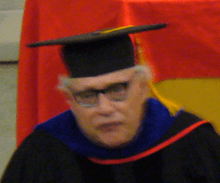Stephen E. Harris

Stephen Harris
Stephen E. Harris (born November 29, 1936, Brooklyn, New York) is an American physicist known for his contributions to electromagnetically induced transparency (EIT),[1][2] modulation of single photons, and x-ray emission. In a diverse career, he has collaborated with others to produce results in many areas, including the 1999 paper titled “Light speed reduction to 17 metres per second in an ultracold gas,” [3] in which Lene Hau and Harris, Cyrus Behroozi and Zachary Dutton describe how they used EIT to slow optical pulses to the speed of a bicycle. He has also contributed to developments in the use of the laser, generating paired photons with single driving lasers [4] He has also shown the development of such pairs of photons using waveforms [5] His more recent work has sought to address restraints imposed on the types of waveforms that can be produced by the single-cycle barrier [6] Harris and colleagues succeeded in this endeavour in 2005 during a series of experiments aimed at obtaining full control of waveforms, noting "we were able to vary the shape of the pulse to generate different prescribed waveforms." [7] It is hoped that these results will lead to coherent control of chemical reactions, as a probe for ever-shorter physical processes, and for highly efficient generation of far infra-red and vacuum ultra-violet radiation.
Education
Awards
Honours
References
- ↑ S. E. Harris, Lasers without inversion: interference of lifetime-broadened resonances, Phys. Rev. Lett. 62, 1033-1036 (1989).
- ↑ K. J. Boller, A. Imamoglu, S. E. Harris, Observation of electromagnetically induced transparency, Phys. Rev. Lett. 66, 2593-2596 (1991).
- ↑ Light speed reduction to 17 metres per second in an ultracold atomic gas Lene Vestergaard Hau, S. E. Harris, Zachary Dutton & Cyrus H. Behroozi Nature 397, 594-598 (18 February 1999)
- ↑ "Generation of Narrow Bandwidth Paired Photons: Use of a Single Driving Laser," P. Kolchin, S. Du, C. Belthangady, G. Y. Yin, and S. E. Harris, "Phys. Rev. Lett. 97", 113602-1/113602-4 (September 2006).
- ↑ V. Balic, D. A. Braje, P. Kolchin, G. Y. Yin, and S. E. Harris, "Generation of Paired Photons with Controllable Waveforms," Phys. Rev. Lett. 94, 183601-1/183601-4 (May 2005).
- ↑ M. Y. Shverdin, D. R. Walker, S. Goda, G. Y. Yin, and S. E. Harris, "Breaking the Single-Cycle Barrier," Photonics Spectra 39, 92-105 (February 2005).
- ↑ Breaking the Single-Cycle Barrier
External links
